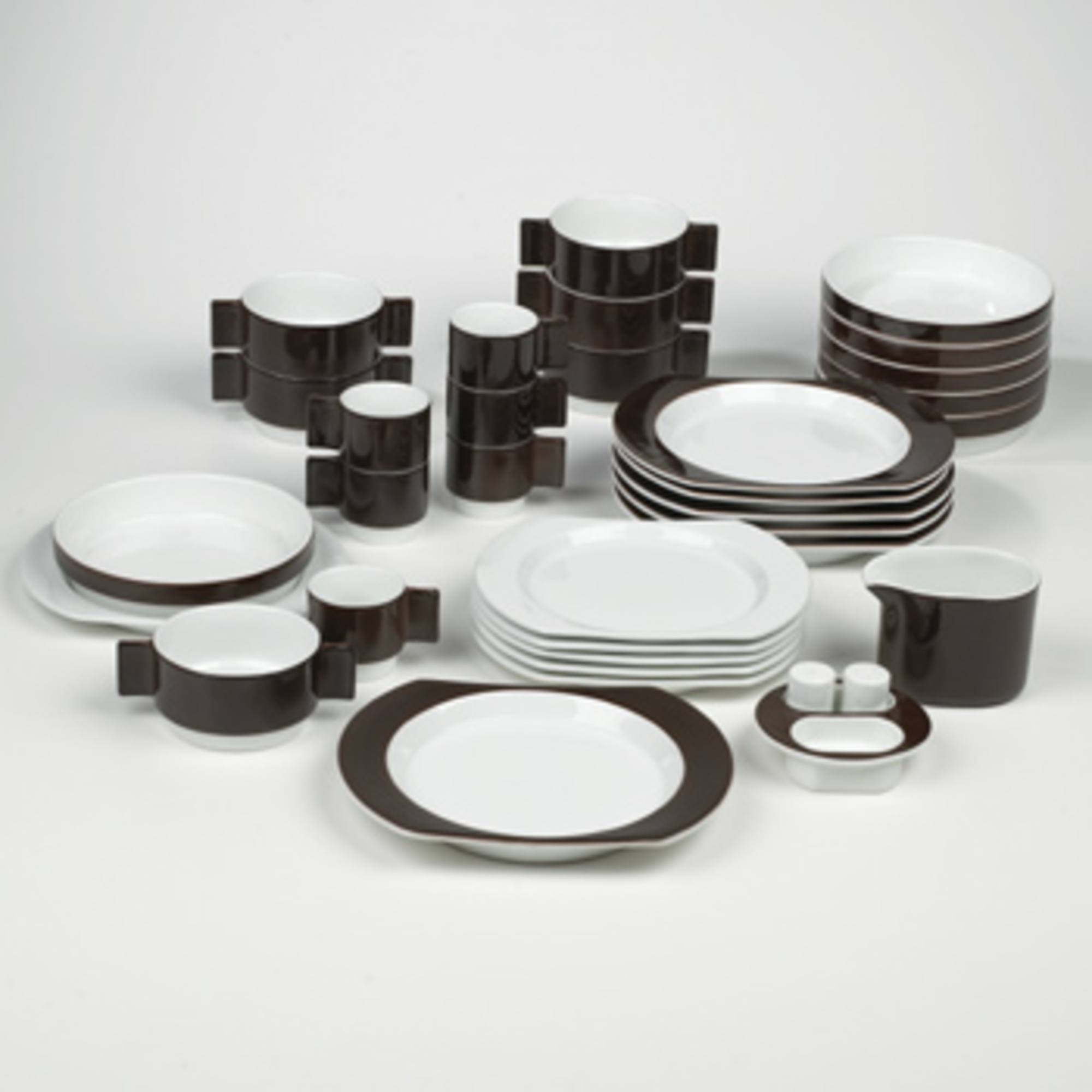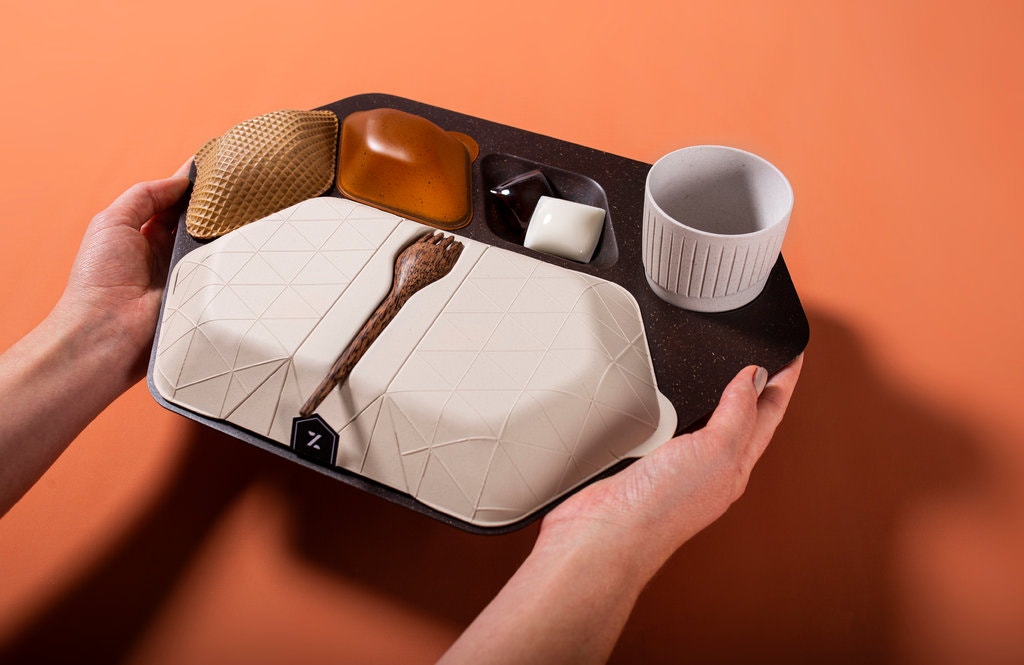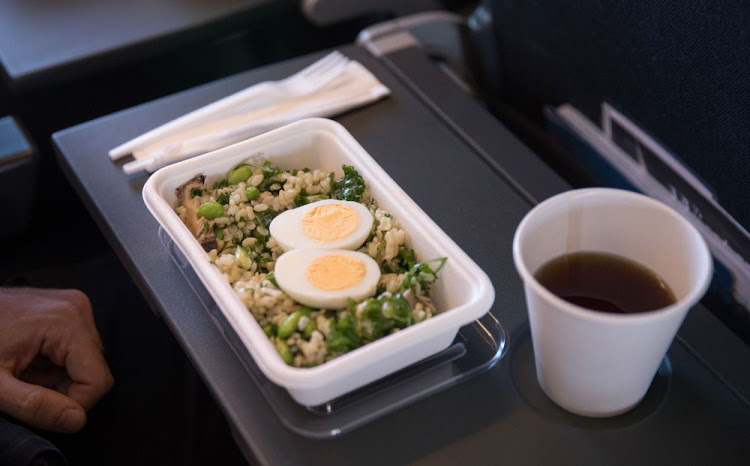Meal
Tray

The average airline passenger leaves behind around 3 pounds of garbage per flight, and a substantial portion of that comes from the packaging of inflight meals.
︎︎︎ Related entries:
In-Flight Food
Meal Trolley
︎ Random Entry
Tags: product design, materials,
sensory (taste, smell, thermal),
sustainability, consumption
In-Flight Food
Meal Trolley
︎ Random Entry
Tags: product design, materials,
sensory (taste, smell, thermal),
sustainability, consumption
Design Decisions
In the early days of in-flight catering, it was typical for airline meals to be served on the passenger’s lap, atop a pillow. After initial experimentation with pillows, covers that transformed into pedestals, and folding tables that were inserted into armrests during meal times, the integrated tray tables on seatbacks became the industry standard by the mid-1950s [1]. Since then, the design and dimensions of the seatback tray table have strongly determined the design of the meal tray, leaving little room for either to maneuver.
Airlines commissioned a number of notable product designers to take on the in-flight tableware as a challenge, including Robin Day, who would write in 1968:
“This was an interesting exercise in logistics… as the economy of space and weight in even the smallest things are crucial to the economics of operating passenger aircraft.
Relationships of dimensions and stacking were essential on several levels: first the compact fitting of vessels and implement of trays; secondly the exact accommodation of trays on mobile trolleys; and thirdly, the accommodation of this equipment on the galley, on the airfield and in the airport” [2].
In addition to the modular aspects of the design, the tray has to meet strict material specifications as well. It must be heat and cold resistant, to withstand the hot temperature during the cooking and sterilization, and cold temperatures during storage. It also needs to resist scratching from utensils and chemicals used in regular cleaning. Finally, it needs to withstand the movements of being in the air without shifting and spilling its contents.

Effects on Passengers
One of the earliest designs of airplane meal trays was developed in 1937 through the collaboration of Don Magarrell, a hotel manager hired by United Airlines, and Industrial Designers Inc., a product design atelier [3]. This design set the standard for our current three-course meal and the corresponding meal tray on the plane, consisting of depressions for appetizers, main dish, and dessert. The economy class meal tray has not changed much from that in the last eight decades, keeping the three-course meal as standard. Only in the last few years have airlines begun to vary from the three-course meal, partially in response to growing pressures about the amount of food waste generated by each flight.
With increasing attention given to the environmental impact of air travel, passengers have begun to question what happens to the meal tray, packaging, and leftover food after the meal. The average airline passenger leaves behind around three pounds of garbage per flight [4], and a substantial portion of that comes from the packaging of in-flight meals. In 2017 alone, it was estimated that the airline industry produced up to 5.7 million tonnes of cabin waste, over 20% of which was untouched food and drinks [5]. In addition, most of the resulting waste cannot be recycled or reused due to differing international regulations and concerns about biosecurity or the spread of diseases. Rethinking food presentation and packaging will be critical to addressing the growing sustainability concerns about air travel.

What-Ifs
What if the meal trays were compostable?
The air travel experience design consultancy PriestmanGoode redesigned the dining trays out of processed coffee grounds and husks and made them compostable, while preserving the plastic appearance of trays with which passengers are familiar. “If you picked it up, you wouldn’t know it wasn’t plastic,” Jo Rowan, the associate strategy director of the firm, stated in an interview [6].
 Priestman Goode’s design for a compostable tray
Priestman Goode’s design for a compostable trayWhat if airlines rethought the form of the three-course meal tray?
Qantas Airlines has been a leader in the industry in the effort to reduce airline waste [4], pledging “to eliminate 100 million pieces of single-use plastic from flights by the end of 2021 [...and] reduce its waste by a whopping 75 per cent” [7]. As part of this effort, Qantas has been rethinking the meal tray altogether. Instead of the standard design of the three-course tray, with allocated spaces for appetizers, main course, and dessert, the airline ditched the tray altogether and uses a single “serving plate” for the main course. While serving the meals, flight attendants also offer a warmed, pre-buttered bread, as well as dessert in a disposable pot. This allows passengers to refuse these extra items if they wish, which allows these items to be donated rather than thrown away [8].
 Qantas Airlines one-course meal packaging, in order to reduce airline waste
Qantas Airlines one-course meal packaging, in order to reduce airline waste- Eisenbrand, Jochen. 2004. “Dining Aloft.” In Airworld: Design and Architecture for Air Travel. Vitra Design Museum.
-
Houston, Lynn Marie. 2004. “Airplane Food.” In The Oxford Encyclopedia of Food and Drink in America. Oxford University Press.
-
“Robin Day in a letter to Lesley Jackson, quoted in: Lesley Jackson, Robin and Lucienne Day. Pioneers of Modern Design, New York, 2001, p. 138.
-
“Airline Cabin Waste.” IATA. Accessed October 1, 2019.
-
WRAP, Nina Sweet, Eleanor Morris, Mark Roberts, and Keith Patterson. 2019. “IATA Cabin Waste Handbook.”
-
Rueb, Emily S. 2019. “Airline Food Waste Is a Problem. Can Banana Leaves Be Part of the Solution?” The New York Times, October 11, 2019.
-
Greig, Alex. “Introducing Qantas’ First Landfill-Free Flight.” Qantas | Travel Insider, May 8, 2019.
-
Maszczynski, Mateusz. "The Revolutionary 'No Tray' Airplane Meal: Why Don't More Airlines Copy the Example of Australian Carrier, Qantas?" Paddle Your Own Kanoo. November 21, 2017.